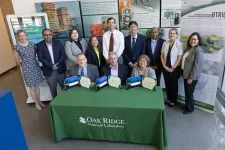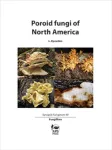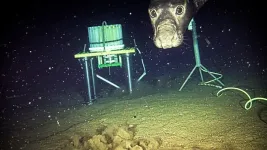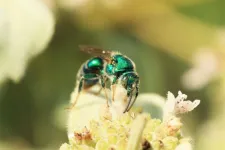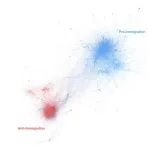(Press-News.org) New research published in the Journal of Sport and Health Science led by the University of Massachusetts Amherst shows that super spikes, scientifically described as advanced footwear technology (AFT) spikes, can give runners about a 2% edge in middle-distance track races, like the 800- and 1,500-meters.
“Track athletes started wearing super spikes about five years ago and they are now commonplace in elite track races,” says Wouter Hoogkamer, assistant professor of kinesiology at UMass Amherst and senior author of the paper.
“Super spikes have a thicker yet lighter, more resilient and more compliant midsole often combined with a stiff-carbon-fiber plate embedded in the midsole,” further explains Montgomery Bertschy, a doctoral student in Hoogkamer’s UMass Integrative Locomotive Lab and joint first author of the paper.
“Over the past five years many track records have been broken and that will not be much different during these Olympics,” Hoogkamer adds. “Many credit the recent developments in spike technology for this, but scientifically, we don’t know that they help. Are athletes running faster because the spikes are faster, or just because they are training better or run on faster tracks?”
To answer this, Hoogkamer brought together an international team of researchers, including Ethan Wilkie, a graduate student at the University of New Brunswick in Canada, and Victor Rodrigo-Carranza, a then-graduate student at the University of Castilla-La Mancha in Spain.
Over a series of experiments, the researchers compared different designs of super spikes with a typical traditional track spike shoe: lightweight in construction with minimal cushioning and no added bending stiffness elements. They found that various designs of super shoes improved running speeds by about 2%, ranging from anywhere from 1.8% to 3.1%.
This begs the question: How much could a 2% speed improvement influence the competition? “A lot,” says Wilkie, “we’re showing that shoes matter and particularly that spikes of some brands performed better than others. Historically, we can expect to see differences of less than 0.5% in race time determining who will win the gold, who will get silver, or will not make the podium. Our 2% findings highlight that some of that might be because some people have slightly better shoes than others.”
“At the Olympics very few athletes will be running in traditional spikes, but it is important to realize that not all super spikes are equal,” Hoogkamer adds. In the final experiment of the study, the researchers evaluated commercially available shoes. They found that the PUMA evoSPEED LD Nitro Elite+ and Nike ZoomX Dragonfly showed significant improvements in speed of about 2%, but a third model of a different brand showed only 1% improvement and that was statistically not better than the traditional spikes.
While Hoogkamer’s previous research showed the benefit of super shoes in marathons, quantifying this for middle-distance track events came with unique challenges. To test the impact of super shoes on marathon runners, scientists typically measure the air that runners are breathing out while they run at marathon pace on a treadmill. “When athletes run at middle-distance race pace, however, there’s a substantial contribution of anaerobic energy metabolism that we don’t capture by measuring the athletes’ breaths,” explains Rodrigo-Carranza. Instead, the researchers relied on their own experiences as (former) competitive middle-distance runners and developed a new protocol where they asked athletes to run a series of 200m intervals at self-perceived middle-distance race pace, a common work-out for middle-distance runners.
Bertschy highlights the scientific rigor that enabled this team to distill the impact of the shoe design from other variables specifically for middle-distance running performance. “From the literature, we know that shoe mass has an important effect on the metabolic cost of running, and that each 100 grams added to the foot, increases the energy cost of running by about 1%, which in its turn will slow down runners by 0.6% at these running speeds,” he explains. So, in their first experiment, they added 200 grams to each shoe of a pair of spikes that was identical to the control spikes to induce a 2% higher energy cost to the runner. They predicted that this would result in a 1.2% decrease in speed. If their predictions were right, it would validate that their methods were accurately capturing the effect of just the shoe. And it did just that.
Over in Spain, Rodrigo-Carranza then assessed the reliability of their new protocol by asking his participants to run in three different spike models not just once, but on three separate days. When assessing the group differences between the three spike models, the researchers found the exact same results on each of the three days, further proving the robustness of this protocol.
As for how super spikes make people faster, the researchers found that the runners took longer steps, rather than faster steps. “Our results also indicate that, over a 1500m race, our participants would take 17 to 21 steps less in super spikes as compared to traditional spikes,” says Hoogkamer.
Hoogkamer envisions the innovations that come with this new method. “Different brands are actually using this protocol now to evaluate their spikes and to find out what’s best for a specific distance or for a specific athlete that is either stronger or heavier or faster,” he says. “You can go to a specific athlete, have them test spikes with our new protocol and find out: do you need to wear spike A or B?”
As for what non-Olympians can take away from this study, he says it can help people understand that, yes, athletes are training harder, but also: it’s about the shoes. “This study is mainly going help them interpret that what they see at the Olympics or when world records are broken—that part of it is because the shoes are getting better and better, and we have evidence for that.”
END
New UMass study shows that ‘super spikes’ can increase track running speed by 2%
Shoe selection may have a bigger impact on running performance than previously imagined
2024-09-04
ELSE PRESS RELEASES FROM THIS DATE:
Department of Energy announces $118 million for Energy Frontier Research Centers
2024-09-04
WASHINGTON, D.C. -Ten Energy Frontier Research Centers (EFRCs) designed to bring together world-class teams of scientists for groundbreaking fundamental research have been funded in nine states by the U.S. Department of Energy (DOE).
Since 2009, EFRCs have brought together diverse, world-class teams of scientists to perform basic research that accelerates ground-breaking scientific advances underlying energy technologies.
The centers develop powerful new tools for characterizing, understanding, modeling, and manipulating matter, while training the next-generation scientific workforce by attracting talented students passionate about energy science.
“Fundamental ...
ACC Quality Summit highlights critical value of ACC accreditation and NCDR services
2024-09-04
The American College of Cardiology (ACC) Quality Summit 2024 will take place on September 17-19 in San Antonio, bringing together cardiovascular leaders from across the nation to discuss the value of NCDR services and quality programs.
“ACC’s Quality Summit puts the spotlight on the value of ACC Accreditation and NCDR services for improving health care quality across all health systems,” said ACC Quality Summit Chair Olivia N. Gilbert, MD, MSc, FACC, and Director of Quality and Value for Cardiovascular Medicine at Atrium Health Wake Forest ...
Coatings manufacturer and ORNL partner Flexcon licenses self-healing film technology
2024-09-04
Flexcon Global has exclusively licensed two patented inventions to manufacture a self-healing barrier film from the Department of Energy’s Oak Ridge National Laboratory for research and development purposes. The film can be incorporated into vacuum insulation panels to increase the efficiency of buildings during retrofits.
Flexcon, based in Spencer, Massachusetts, provides coatings, film laminations and functional technologies to a range of markets including healthcare, sustainable packaging, transportation, consumer durables, electronics, industrial, retail and advertising.
Under ...
A new, updated account of poroid fungi in North America
2024-09-04
Poroid fungi, commonly known as "polypores," are among the most frequently encountered fungi throughout the year because of their large size and longevity. Despite the common presence of poroid fungi in North America, most guides include only a limited selection of these fungi. Poroid Fungi of North America, by Leif Ryvarden, offers a necessary, updated account of these fungi, building on the foundational work of the original two-volume North American Polypores, by Ryvarden and R. L. Gilbertson, published in 1987. This comprehensive update incorporates more than three decades of new research, featuring detailed keys, descriptions, and vibrant color ...
Collaborative research to benefit coastal flounder populations and fishers
2024-09-04
Four faculty members from three departments in the College of Natural Resources and Environment have received $1.7 million from the National Science Foundation to fund research into the dynamics of socio-environmental factors impacting coastal fisheries.
Holly Kindsvater and Willandia Chaves of the Department of Fish and Wildlife Conservation, Craig Ramseyer of the Department of Geography, and Michael Sorice of the Department of Forest Resources and Environmental Conservation will collaborate with Jonathan van Senten and Fernando Gonçalves of the Virginia Seafood Agricultural Research ...
WashU scientists uncover hidden source of snow melt: Dark brown carbon
2024-09-04
Wildfires leave potent climate heaters behind in their wake, particles that enhance the absorption of sunlight and warm the atmosphere. Dropped on snow like a wool poncho, these aerosols darken and decrease the surface reflectance of snowy places.
But it was not yet understood just how different types of smoke particles contribute to these effects. In a study recently published in npj Climate and Atmospheric Science, researchers at Washington University in St. Louis model how dark-brown carbon (d-BrC) – light absorbing, water insoluble organic carbon – from wildfires plays a much larger role as a snow-warming agent than previously recorded. ...
Young male northern elephant seals are captured on camera returning to a deep sea cabled observatory off Canada's British Columbia coast, demonstrating new insight into fish foraging behavior
2024-09-04
Young male northern elephant seals are captured on camera returning to a deep sea cabled observatory off Canada's British Columbia coast, demonstrating new insight into fish foraging behavior
###
Article URL: https://journals.plos.org/plosone/article?id=10.1371/journal.pone.0308461
Article Title: Deep-sea cabled video-observatory provides insights into the behavior at depth of sub-adult male northern elephant seals, Mirounga angustirostris
Author Countries: Canada, USA, Spain
Funding: Ocean Networks Canada (ONC) is funded through the Canada Foundation for Innovation-Major Science Initiative ...
Both cats and dogs often enjoy playing fetch with their owners
2024-09-04
This release has been removed per request of the submitting organization due to a duplicate submission. You can find the embargoed release here: https://www.eurekalert.org/news-releases/1055807
For more information, please contact: Charlotte Bhaskar, cbhaskar@plos.org END ...
Flower Power: providing blooms all season long may be the key to attracting pollinators, no matter what landscape your garden is near
2024-09-04
A diverse and abundant flower planting that provides flowers in bloom all season may be more important to bees and other pollinators than whatever is surrounding the flower garden, according to a study published September 4, 2024 in the open-access journal PLOS ONE by Devon Eldridge from the University of Tennessee, US, and colleagues.
As we learn more about how critical pollinators (native and non-native bees, butterflies, and other insects) are to our food supply and ecosystem, many people are planting pollinator-attractive ...
Few anti-immigration users dominate most of UK-based anti-immigration content on Twitter with rapid spread and high polarization
2024-09-04
A study of more than 200,000 tweets from 2019 and 2020 finds that anti-immigration content spreads faster than pro-immigration tweets and that a few users disproportionally generated most of the UK-based anti-immigration content. Andrea Nasuto and Francisco Rowe of the Geographic Data Science Lab at the University of Liverpool, UK, present these findings in the open-access journal PLOS ONE on September 4, 2024.
Online social media platforms are widely considered to contribute significantly to rising tensions in debates about immigration. Increased online polarization, the clout of key influencers, ...
LAST 30 PRESS RELEASES:
Fires could emit more air pollution than previously estimated
A new way to map how cells choose their fate
Numbers in our sights affect how we perceive space
SIMJ announces global collaborative book project in commemoration of its 75th anniversary
Air pollution exposure and birth weight
Obstructive sleep apnea risk and mental health conditions among older adults
How talking slows eye movements behind the wheel
The Ceramic Society of Japan’s Oxoate Ceramics Research Association launches new international book project
Heart-brain connection: international study reveals the role of the vagus nerve in keeping the heart young
Researchers identify Rb1 as a predictive biomarker for a new therapeutic strategy in some breast cancers
Survey reveals ethical gaps slowing AI adoption in pediatric surgery
Stimulant ADHD medications work differently than thought
AI overestimates how smart people are, according to HSE economists
HSE researchers create genome-wide map of quadruplexes
Scientists boost cell "powerhouses" to burn more calories
Automatic label checking: The missing step in making reliable medical AI
Low daily alcohol intake linked to 50% heightened mouth cancer risk in India
American Meteorological Society announces Rick Spinrad as 2026 President-Elect
Biomass-based carbon capture spotlighted in newly released global climate webinar recording
Illuminating invisible nano pollutants: advanced bioimaging tracks the full journey of emerging nanoscale contaminants in living systems
How does age affect recovery from spinal cord injury?
Novel AI tool offers prognosis for patients with head and neck cancer
Fathers’ microplastic exposure tied to their children’s metabolic problems
Research validates laboratory model for studying high-grade serous ovarian cancer
SIR 2026 delivers transformative breakthroughs in minimally invasive medicine to improve patient care
Stem Cell Reports most downloaded papers of 2025 highlight the breadth and impact of stem cell research
Oxford-led study estimates NHS spends around 3% of its primary and secondary care budget on the health impacts of heat and cold in England
A researcher’s long quest leads to a smart composite breakthrough
Urban wild bees act as “microbial sensors” of city health.
New study finds where you live affects recovery after a hip fracture
[Press-News.org] New UMass study shows that ‘super spikes’ can increase track running speed by 2%Shoe selection may have a bigger impact on running performance than previously imagined



